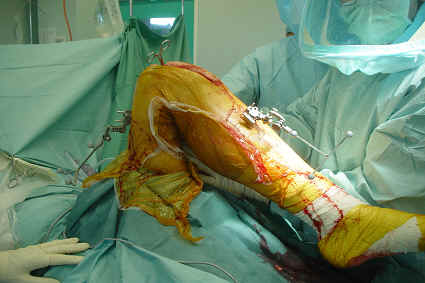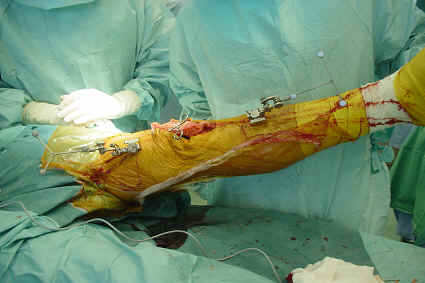|
Abstract:
Intra-operative
estimation of range of flexion, extension, varus and valgus of
the knee is important in ligament balancing and implant
selection during total knee replacement (TKR). Many outcome
studies of TKR are also based on surgeons’ estimation of
post-operative range of movement. There are currently no
published papers which demonstrate how precise surgeon
assessment of range of movement of the knee is. This study
evaluated the accuracy of surgeons’ estimation of maximal
range of flexion, extension, varus and valgus of the knee
compared to simultaneous computer navigated reading of the same
knee movements during TKR in 100 patients. The surgeons were
very accurate at assessing extension, varus and valgus but
consistently underestimated flexion of the knee
J.Orthopaedics 2007;4(2)e21
Introduction:
Clinically
assessing the range of motion and laxity of a knee
intra-operatively is an essential part of total knee
replacement. The surgeon relies on this judgement of flexion,
extension, varus and valgus for implant selection and optimal
ligament balance. Assessing the range of movement of the knee in
the outpatient setting is also an outcome measurement for many
studies of TKR1-3. However, to our knowledge there are no
published studies which evaluate how accurate surgeons are at
estimating knee range of movement intra-operatively. This study
evaluated the surgeons’ assessment of maximal range of knee
flexion, extension, varus and valgus in flexion and varus and
valgus in extension compared to simultaneous computer navigation
reading of the same knee movement.
Material and Methods :
100
consecutive patients undergoing primary posterior stabilized
Genesis II TKR (Smith and Nephew) with Brainlab image free
computer navigation (Brainlab Australia Pty Ltd) were studied.
There were no exclusion criteria for patients in this study.
Four surgeons participated, two experienced knee arthroplasty
surgeons and two senior orthopaedic fellows.
A
thigh tourniquet was used for all patients. The tibial and
femoral pins for the fixed navigation points were inserted. The
knee was accessed via a medial parapatellar approach, and the
acquisition of mapping points for the navigation system
completed. Accuracy of the pin placement is not relevant as the
computer builds a picture of the mechanical axis in 3D based on
over 200 acquisition points provided by the surgeon, including
the malleoli, Whiteside’s line, the antero-posterior tibial
direction and the hip centre. These points are referenced to the
pins in place, not the pin placement providing the reference.
Bone resections were performed with guidance from the Brainlab
image-free navigation system.
During
the final trial reduction of implants, a towel clip was applied
to the patella retinaculum to simulate knee closure. The surgeon
estimated the range of maximal knee flexion by holding the thigh
vertically with the hip flexed 90 degrees and allowing the knee
to flex freely under gravity (figure 1), the surgeon used a
goniometer to measure the maximal flexion. For the surgeon to
evaluate extension of the knee, the patients’ foot was
supported and the knee allowed to extend freely to its’
maximal extension position under gravity (figure 2). Varus and
valgus of the knee were evaluated with the knee in extension,
and then with the knee in 90 degrees of flexion.
|

|

|
|
Figure 1.
Position of the leg for evaluation of knee flexion |
Figure 2. Position
of the leg for evaluation of knee extension |
The
surgeon was unable to see the computer during the stage of the
operation where the range of movement was evaluated. The
estimation of range of movement was compared to that displayed
simultaneously by the computer navigation system. The difference
in degrees of angulation between the surgeon estimation of a
movement in one plane and the computer measurement of the same
movement was calculated.
Results :
The
overall results are summarized in table 1. The surgeons
consistently underestimated knee flexion, the mean
underestimation of knee flexion was 12.8° for each patient. The
surgeons were good at true estimation of varus and valgus
compared to the computer navigation measurement of the same
angles, showing accuracy to within one degree. Surgeon
estimation of true extension of the knee was also accurate, any
discrepancy from the true value was an overestimation of any
hyperextension
| Movement
of the knee |
Mean
difference between surgeon estimation and computer
measurement in degrees of angulation (standard
deviation) |
| Extension |
0.10
(3.8) |
| Valgus
in extension |
0.11
(0.96) |
| Varus
in extension |
0.02
(1.17) |
| Flexion |
12.8
(6.4) |
| Valgus
in flexion |
0.06
(2.28) |
| Varus
in flexion |
0.29
(1.69) |
There
was no inter-observer difference between the individual surgeons
estimation of range of movement. All four surgeons consistently
underestimated flexion to the same level of inaccuracy. The two
most experienced surgeons were marginally better at estimating
varus and valgus, but because the degree of inaccuracy was so
low this was not significant
Discussion :
Surgeons
consistently underestimated intra-operative knee flexion
compared to simultaneous computer measurement of the same knee
position. They were reasonably accurate at evaluating knee
extension, varus and valgus.
There
is no consensus on how knee flexion should be measured. Some
surgeons may take the angle subtended by the anterior contour of
the knee. Others use the estimation of the centre of the knee as
the fulcrum and align the goniometer along the line of the
skeleton from this point. The navigation system measures flexion
from its calculation of the mechanical axis of the leg, this
means that the fulcrum (point of maximal angulation) is actually
anterior to the knee in full flexion.
It
may be difficult for the surgeon to accurately estimate knee
flexion intra-operatively in the obese patient, the line of the
skeleton and hence the mechanical axis is not easy to view.
Surgeons
are good at estimating varus and valgus. This is of utmost
importance in balancing the knee and selection of a tibial
polyethylene insert size. Clinically it is important that the
surgeon can accurately evaluate whether a knee can fully extend
or if hyperextension is occurring. Our study showed that the
surgeons were good at this.
One
limitation of this study is that only four surgeons participated
from a high volume arthroplasty unit, it may be that these
surgeons were not a representative sample of surgeons performing
total knee arthroplasty. Also, the majority of TKRs performed by
the surgeons in the months prior to the study were also computer
navigated. It may be that during the learning curve and
subsequent experience with the computer navigation a surgeon
gets position feedback which improves judgement of flexion,
extension, varus and valgus.
Clinical
implications of underestimation of knee flexion in TKR are not
thought to be significant for the individual patient, but may be
of importance in follow-up studies of different TKR prostheses.
Reference :
-
Hewitt B, Shakespeare D. Flexion vs. extension: a
comparison of post-operative total knee arthroplasty
mobilisation regimes. Knee 2001 Dec;8(4):305-9
-
Pope RO, Corcoran S, McCaul K, Howie DW. Continuous
passive motion after primary total knee arthroplasty. Does it
offer any benefits? J Bone Joint Surg Br1997 Nov;79(6):914-7
-
Harvey IA, Barry K, Kirby SP, Johnson R, Elloy MA.
Factors affecting the range of movement of total knee
arthroplasty. J Bone Joint Surg Br 1993 Nov;75(6):950-5
|




